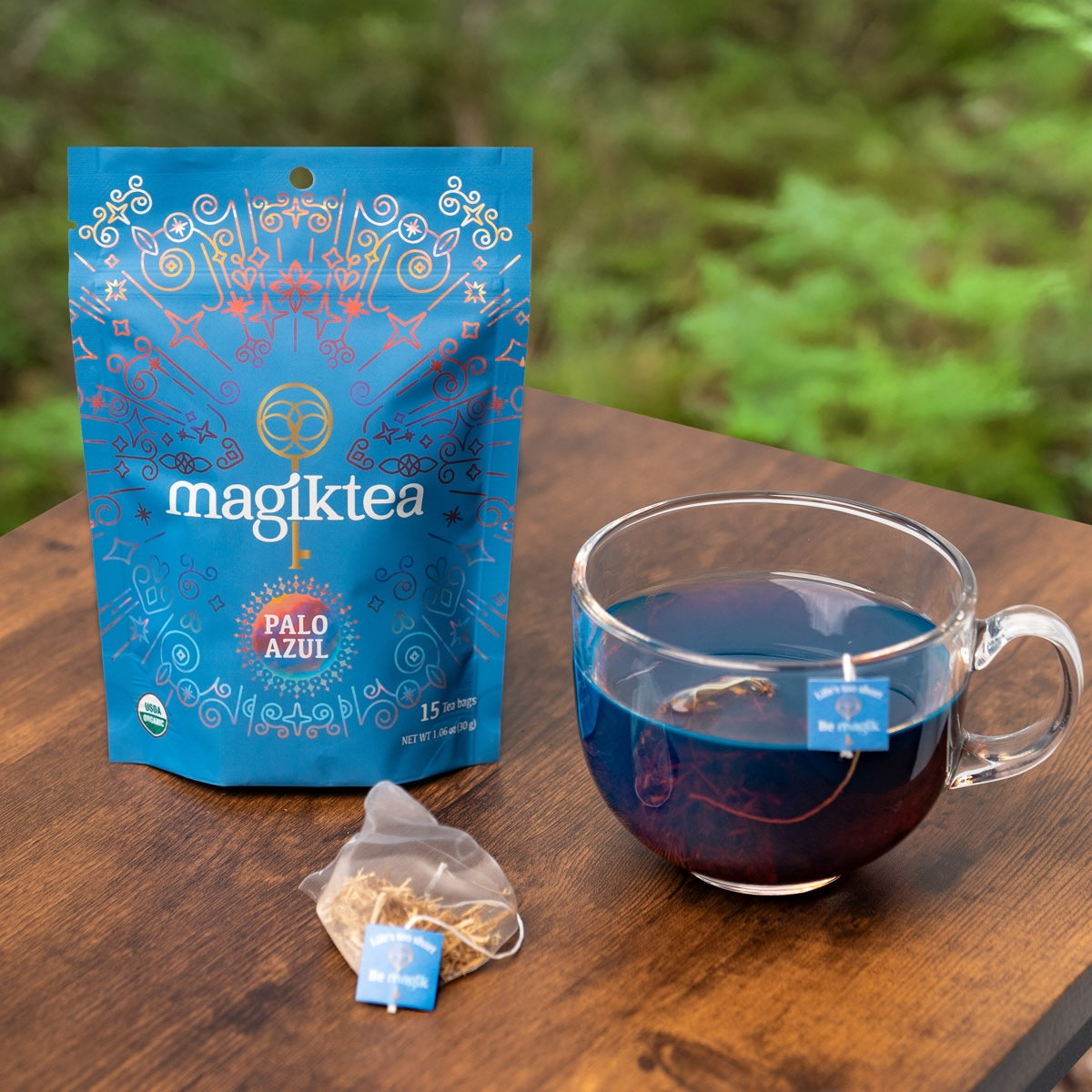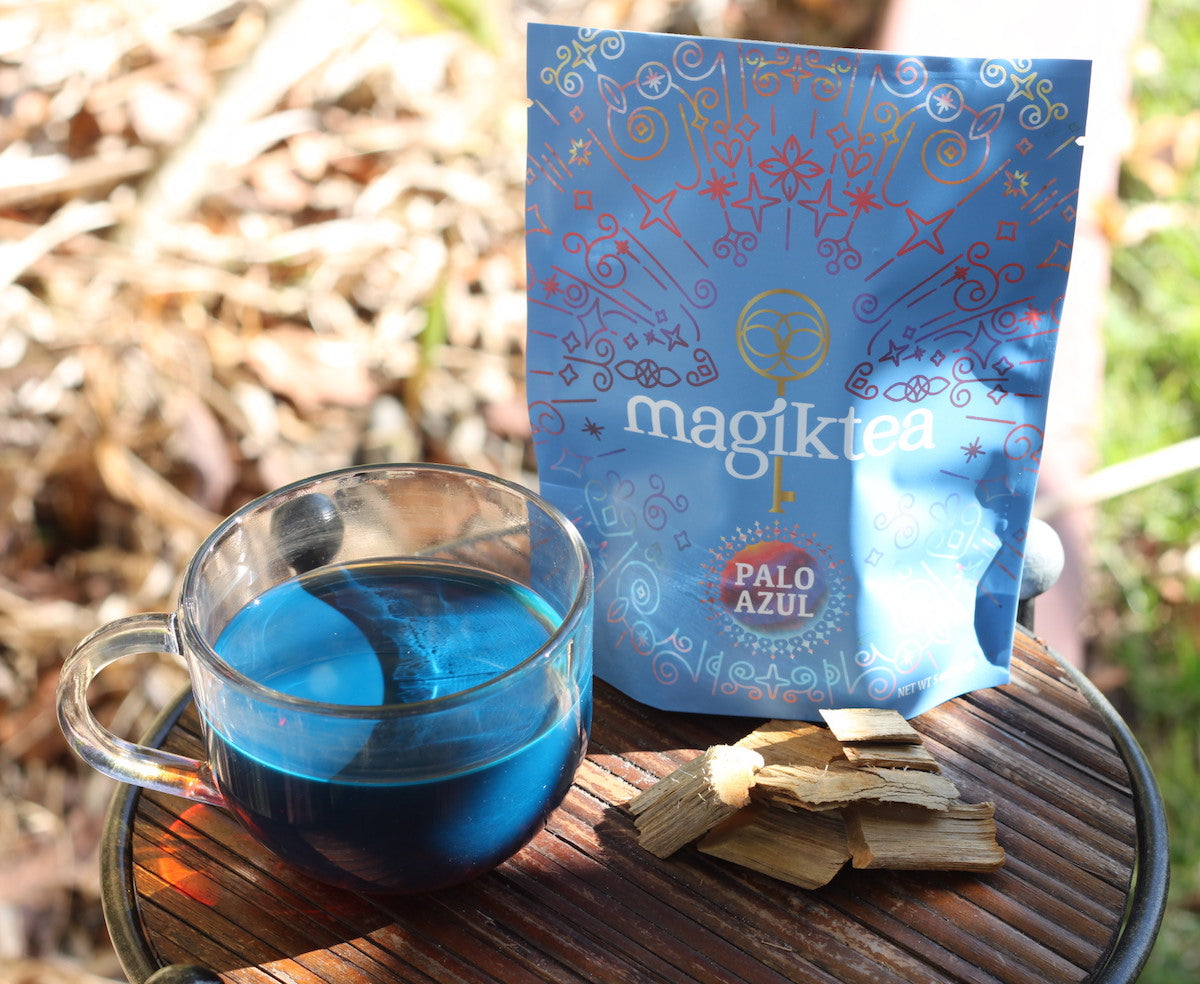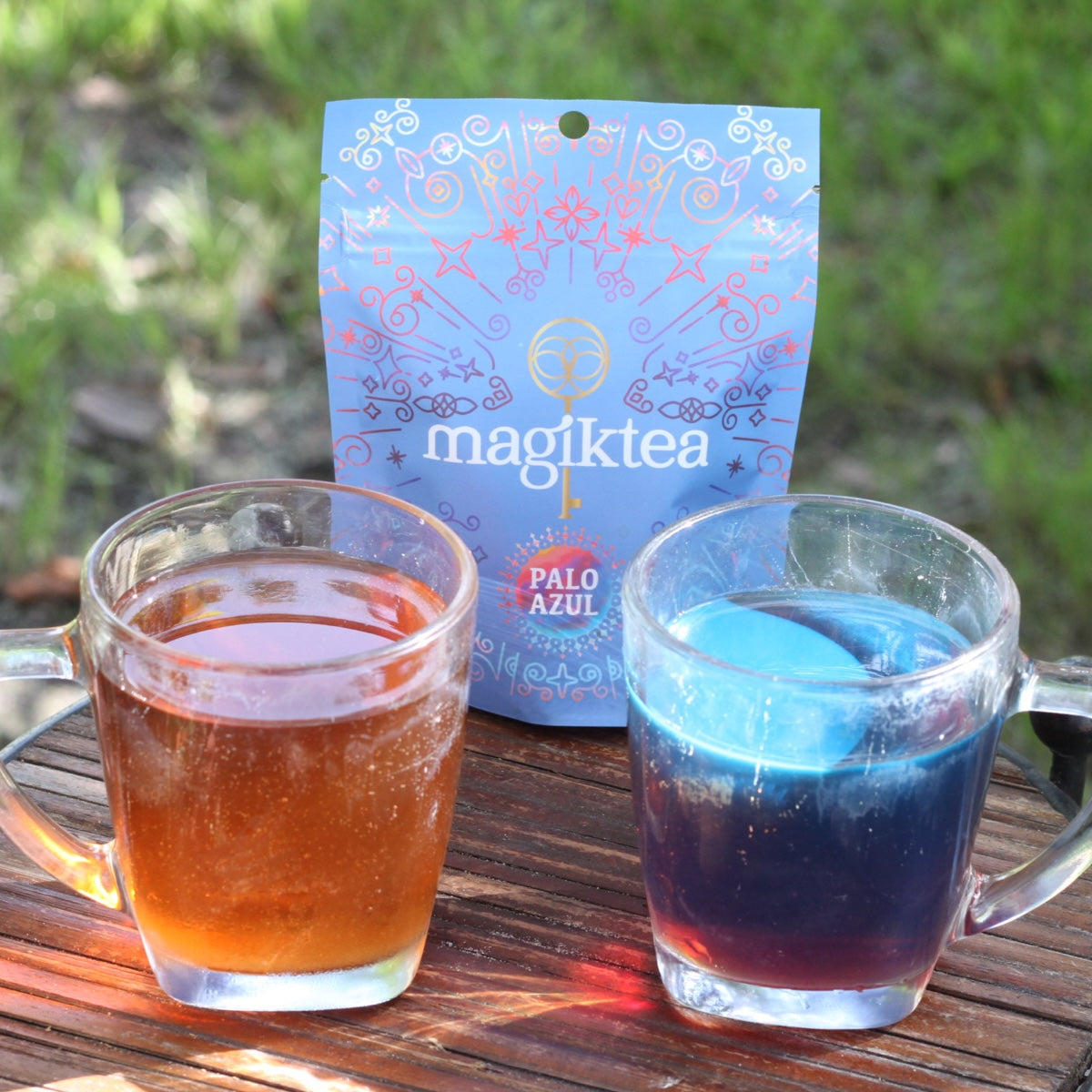The One and Only Kidneywood
Palo azul means "blue wood" in Spanish, and it gets its name because when you boil the plant's wood/bark in water...it produces a fluorescent tea, so it turns blue when it absorbs light! Studies (1, 2, 3) show that palo azul's fluorescence is caused by fluorescent nutrients (flavonoids & polyphenols) that plants produce to defend themselves from oxidative stress, UV light, fungi, and other pathogens.
Some plants evolved the unique ability of fluorescence to defend themselves against excessive UV radiation by absorbing this high energy sunlight, and emitting a lower energy light which is harmless. The palo azul tree evolved these polyphenols as a defense mechanism against excessive UV radiation because it grows in the desert. So when we consume these nutrients, they help us defend against oxidative stress, free radicals, inflammation, etc.
Studies show that palo azul has around 8x more polyphenols (antioxidants) than green tea without the caffeine, and it's anti-inflammatory, liver-protective and kidney-protective. It's also a potassium-saving diuretic, alkaline and it's oxalate-free. Due to these beneficial properties, palo azul tea has been used as a natural remedy for over 500 years in Mexico to promote kidney, liver, and urinary tract function, so it's commonly known as "kidneywood"
What is Palo Azul Tea Good For?

Tasting notes: Most people describe it as earthy, smooth, refreshing, slightly sweet, and bright. Despite palo azul's supernatural blue fluorescence, it has 0 calories and 0 sugar, so it’s not sweet, but you can add honey, monk fruit, stevia, or sugar if you’d like to sweeten it. Many have said that it feels cleansing, detoxifying, or alkalinizing in the body when they drink this magical tea.
Summary of Studies

Anti-inflammatory
Numerous studies show that palo azul exhibited significant anti-inflammatory activity and also inhibited the production of pro-inflammatory cytokines. One study concluded that "these results give support to the use of this plant as an anti-inflammatory in traditional medicine."

Antioxidant
Studies show that palo azul has around 2-8x more polyphenols (antioxidants) than green tea. Due to its high polyphenol content, numerous studies show that palo azul exhibited significant antioxidant activity, it inhibited oxidative stress, free radicals, lipid peroxidation, AGEs, and it boosts glutathione.

Alkaline
Several studies found that palo azul has electrolytes such as potassium, magnesium, sodium and calcium, which give it an "alkalinizing nature". Therefore, palo azul "decreases the acidity of urine" and "dissolves acidic precipitants (kidney stones)". Many studies show that alkaline drinks are better for hydration, digestion and dental health.

Potassium-Saving Diuretic
Several studies show that palo azul tea exhibits diuretic activity and it's a "potassium-sparing diuretic". This means that palo azul flushes out toxins without electrolyte loss because it spares potassium, so it doesn't dehydrate you like regular diuretics such as green tea or coffee, which do flush out electrolytes.

Polyphenols
Many studies have shown that palo azul is rich in polyphenols. A 2021 study identified several types of phytonutrients in palo azul including "flavonoids, polyphenols, phenolic compounds, flavones, flavanones, isoflavones chalcones and dihydrochalcones."

Caffeine-free
Palo azul tea is caffeine-free, so it's great for detoxing later in the day if you consume processed foods or alcohol because it inhibits oxidative stress, inflammation, & lipid peroxidation.
What makes palo azul so magical?

The magic in palo azul is that it has fluorescent polyphenols, so it can absorb high energy light and turn it into this beautiful blue tea. Thousands of studies have shown the incredible properties of polyphenols for improving our health, and palo azul has 8x more polyphenols than green tea. There are many fluorescent plants…but as far as we know, palo azul is the only one that produces a fluorescent tea!
Asides from palo azul's incredible fluorescence, it's also an alkaline tea, as opposed to black tea, hibiscus tea, fruit teas, and some herbal teas which are slightly acidic. You can read our article on the benefits of alkaline drinks here:

Benefits of Alkaline Tea
Palo azul tea is caffeine-free, so you can enjoy the most beautiful tea in the world at any time of the day! Studies show that when caffeine is consumed in excess, it can lead to insomnia, anxiety and digestive issues. This makes palo azul a perfect option for cleansing later in the day or whenever you need a break from caffeine.

Pros & Cons of Caffeine-Free Tea
Also, a 2016 study showed that palo azul is a "potassium-sparing diuretic", meaning that it increases urination without electrolyte loss during urination because it spares potassium...as opposed to regular diuretics like coffee and green tea.
Palo Azul's Incredible Story

Palo azul was popularized shortly after the discovery of America, when it was transported to Europe for its mesmerizing blue fluorescence. In fact, the books "Photochemical & Photobiological Sciences" and "Early History of Solution Fluorescence" both mention that the phenomenon of fluorescence was discovered for the first time in palo azul! Due to its extraordinary fluorescence, Isaac Newton actually studied palo azul and wrote a paper about it. Alexander Graham Bell, the inventor of the telephone, was also amazed by palo azul, along with dozens of other scientists.

This article mentions that because of palo azul's supernatural beauty, cups of this tea "were given as gifts to royalty." The article mentions that Athanasius Kircher, considered to be one of the fathers of the science of fluorescence, "presented the cup to the Holy Roman Emperor, Ferdinand III." Now we feel like royalty drinking our palo azul tea!
Botanical Family

Safford, William Edwin, Public domain, via Wikimedia Commons
Scientific names: Eysenhardtia polystachya, Cyclolepis genistoides, Lignum nephriticum. It's also known as kidneywood or palo dulce (sweet wood).
Botanic family: Fabaceae, leguminosas
This is the family with the third-greatest number of species. The palo azul tree grows in dry locations in Mexico, Texas and Arizona.

How to prepare palo azul

- Boil 1 gallon of alkaline water and add 1 oz of palo azul (1-3 pieces)
- Palo azul tea will only turn blue with alkaline water! Tap water or fridge water is usually alkaline. Avoid using cheap bottled waters because they're usually acidic, so your palo azul won't turn blue. If you're going to use bottled water, make sure the pH is 7+.
- Brew on low heat for 20 minutes. You'll notice the color begins to turn into a blueish amber color.
- Let it cool down, then strain the tea to remove the palo azul and store the tea in the fridge. You can drink the palo azul tea hot or cold.
- Pour the tea in a glass cup, then take it outside so that it can absorb sunlight and enjoy the magical blue fluorescence!
Sources
Palo azul is commonly referred to by its scientific name Eysenhardtia polystachya, Cyclolepis genistoides, lignum nephricitum, kidneywood, kidney tea, or palo dulce.
(2016) Diuretic activity of the bark of Eysenhardtia polystachya
(2007) Early History of Solution Fluorescence: The Lignum nephriticum of Nicolás Monardes








Hi Courtney, if it doesn’t turn blue you’re still getting the benefits because palo azul only turns blue in alkaline water and our stomach is acidic, so the blue would disappear when you drink it anyway. I hope this helps!